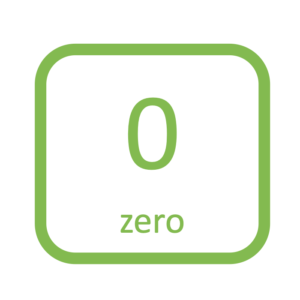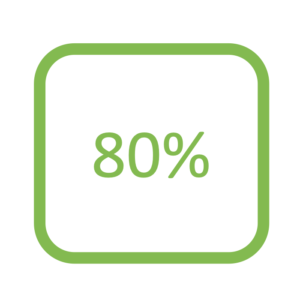Should FHO Doctors Charge for Prescription Renewals?
Absolutely Unequivocally Yes

Family Physicians are suffocating in administrative burden and drudgery that mainly goes unrecognized and unpaid. I recently wrote an article showing how my overhead was up 20% in the last two years alone, yet revenue was down.
Prescription renewals contribute to the workload. Every day, we are inundated with seemingly innumerable requests for prescription renewals from our hundreds of patients.
All of this work costs time and resources.
Yet none of it is reimbursed by OHIP.
OHIP generally only pays for services when the doctor is seeing the patient. When a Family Doctor renews prescriptions without seeing or speaking with the patient, that family doctor is not paid a single dollar for doing so.
The Cost of a Single Prescription Renewal
Know this. Every single prescription renewal that you provide without a visit COSTS you approximately $22 each.
Here is the breakdown:
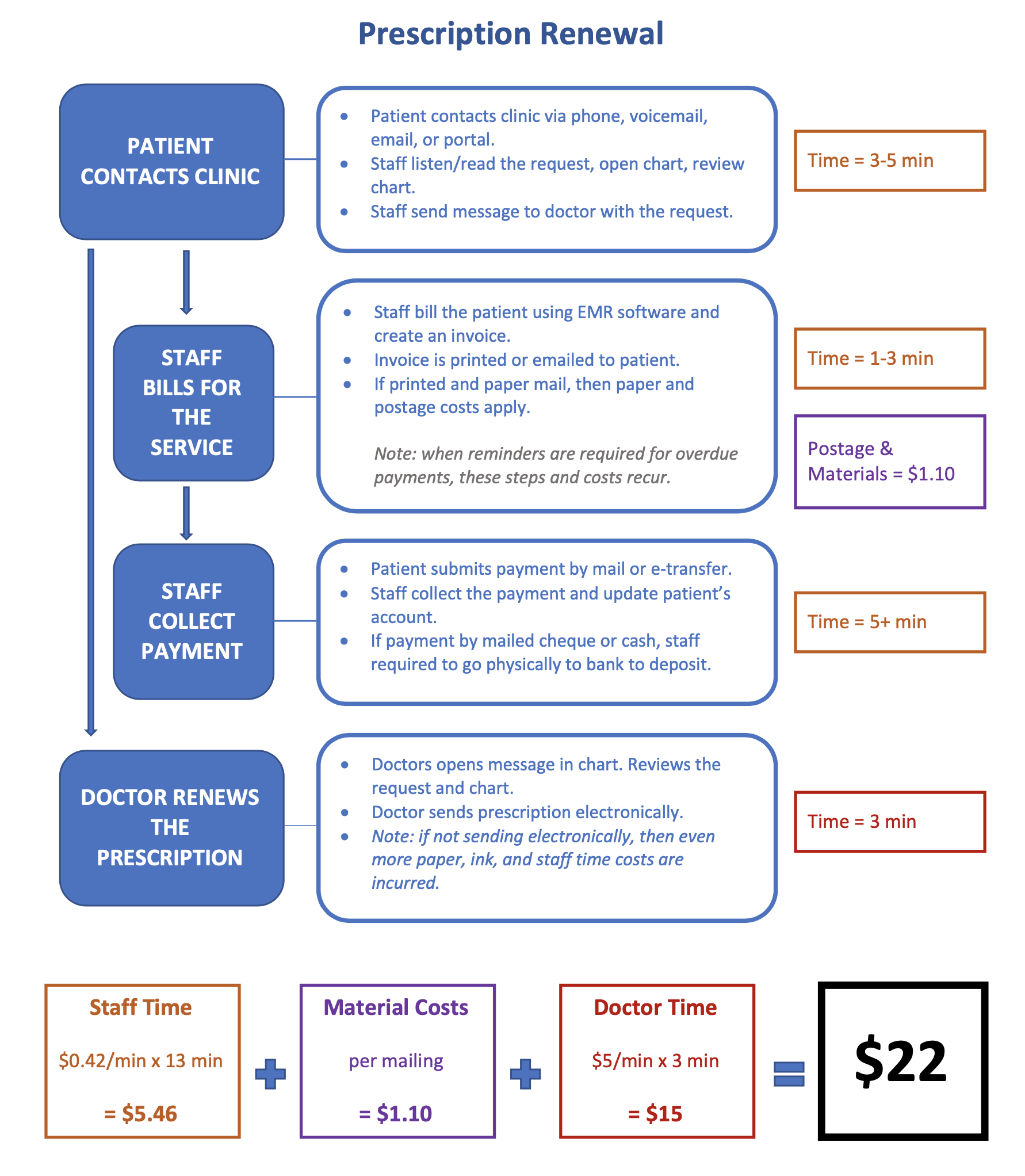
The Cost of Multiple Prescription Renewals:
I work in a clinic with three other doctors and one nurse practitioner. That’s five practices. Naturally, practice styles vary.
I used to track data about prescription renewal requests. Before any of us started charging a fee for prescription renewals without visits, every day each of the clinicians would receive between 5 to 10 prescription refill requests on average.
That $57,200 per year is for an individual clinician. So, in clinics with multiple doctors, the cumulative cost is hundreds of thousands of dollars per year.
This is not about Greedy Profits
As shown above, the costs associated with prescription renewals is enormous. Thus, charging for prescription renewals is not about being a ‘greedy doctor’ trying to turn profits. Rather, it’s about trying to recoup or minimize losses.
Plus, as I will illustrate below, charging a fee is arguably less about generating revenue and more about reducing the burden from the sheer volume of requests.
Charging a Fee is the Only Thing that makes Patients Take Accountability
It’s an unfortunate and bold thing to have to say. But it’s true.
Years ago, we recognized the enormous burden associated with the prescription renewal requests. Again, I was tracking the data for our clinic. And this was before any of us had ever started charging a fee for prescription renewals.
One of the most disheartening findings was that hundreds of individual patients were submitting multiple requests for different medications on different days throughout the same 100-day periods. The inefficiency burden here cannot be understated!
We were fortunate to practice in a small, close-knit, rural community. The vast majority of our patients filled their prescriptions using the single local pharmacy next door. For nearly a year, we collaborated with the pharmacy, exploring ways to reduce the number of prescription renewal requests. We had meetings. We all brainstormed. We tried different strategies including:
- We tried synchronizing medications to all come due at the same time.
- At every visit, we doctors ensure all prescriptions were up to date with refills and we would remind patients of their refills.
- The pharmacist would remind patients of their refills when they were filling prescriptions.
- We would continuously remind patients to call in for all their medications at once, rather than one at a time.
- We had posters in the clinic.
- Our voicemail always reminded patients about all this as well.
Sadly, nothing truly worked. Every day, our office continued to receive a huge number of prescription requests, even from patients who would:
- Already had repeats at their pharmacy;
- Call for one medication one day, and then call for another a few days later (instead of renewing them all at once);
- Call in for a prescription, even though they just recently saw the doctor for a visit.
- Have misplaced prescriptions that were already given.
Then, almost miraculously, the number of prescription requests plummeted once I started charging a fee for prescription refills without visits.
The Undeniable Effect of a Prescription Renewal Fee
The data speaks for itself. Charging a fee for prescription renewals causes the number of requests to dramatically plunge.
The five clinicians in out clinic serve as sort of a cohort study showing the effect.
- I started charging a fee on Nov 1st, 2017.
- “Doctor #3” in our clinic started charging a fee Oct 1st, 2018.
- The other three practices did not charge a fee.
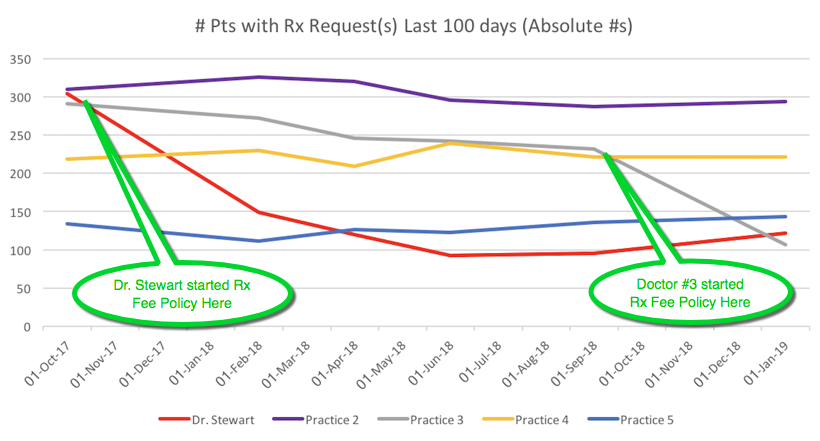
You can see the volume of requests dramatically fall when fees were introduced. And for those who do not charge fees, their volume of requests remains unchanged throughout.
Again, charging a fee for prescription renewals is arguably more about reducing the (evidently avoidable) workload burden, and less about generating revenue!
The FHO Payment Model does NOT include Prescription Refills
It is sometimes perceived that prescription renewal without a visit is a service that is included in the flat-rate payment FHO payment model.
This is categorically false.
The FHO capitation payments are derived from a mathematical mix of insured OHIP fee codes. When the capitation rates were first developed, they were calculated and based upon the average mix of insured services for a patient of each age group and sex.
By definition, Uninsured Services are not included in the FHO capitation payments. And prescription renewals without a visit are not an insured service.
It is NOT Easier and Less Costly to Renew Prescriptions without Visits
We’ve just established that prescription renewals without a visit are not an insured service under the FHO model. So, the next common misconception is that it’s simply easier and less costly to ‘quickly’ renew prescriptions without seeing the patient.
The perception is that it ‘just takes a couple of minutes’ to renew a prescription compared to the time and resources associated with a patient coming in for a visit.
I have clearly illustrated above:
- The cumulative costs associated with prescription renewal are enormous.
- If no fee is charged, there is no patient accountability and the volume of requests runs rampant.
Now, let’s look at some comparative math based on data from my practice and experience.
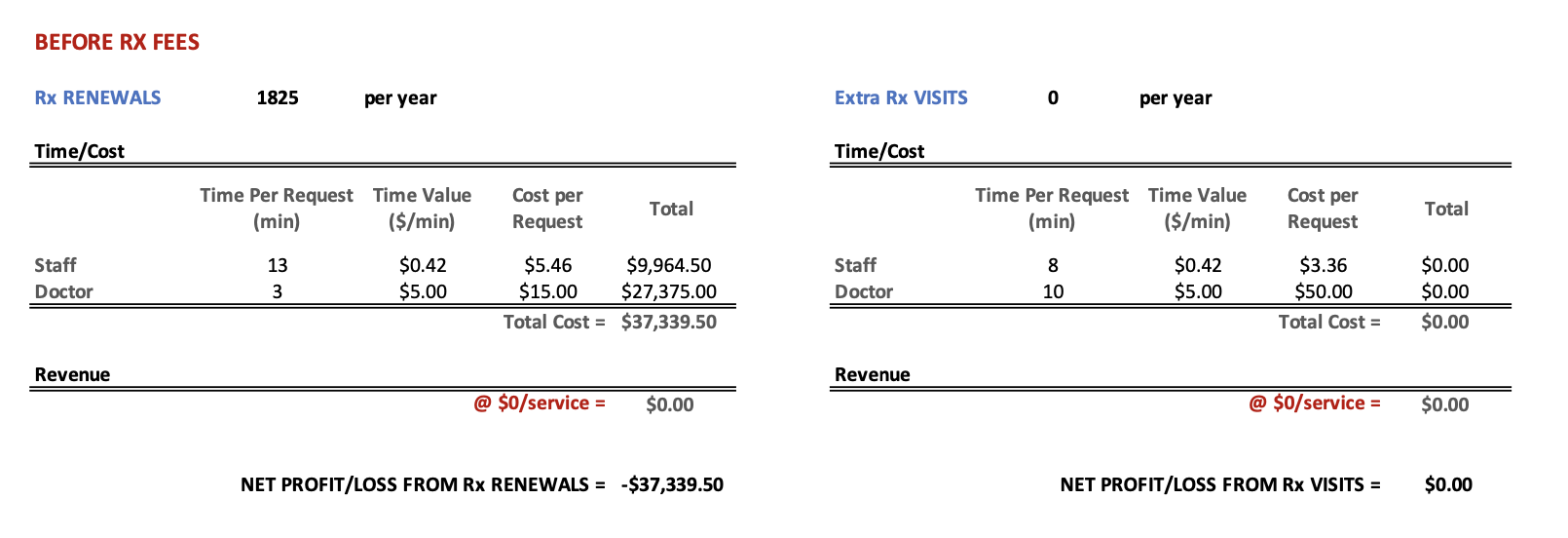
After I started charging prescription renewal fees, naturally some patients opted to come in for a visit rather than pay the fee. Still, the volume of these extra visits was not actually that large. There was an initial hump of work and visits, but after a few months, things quickly settled into place. I was only averaging about 53 prescription “squeeze-in” visits per 100 days, which equates to abut 193 extra visits per year.
For those who came in for a visit, I found these were actually pleasant and refreshing visits. Typically patients I see infrequently. I could get all of the medications prescribed at once with a year’s worth of repeats. And also check off a number of opportunistic preventative care items.
After time, the numbers started looking like this:

In summary, the data is undeniably striking:
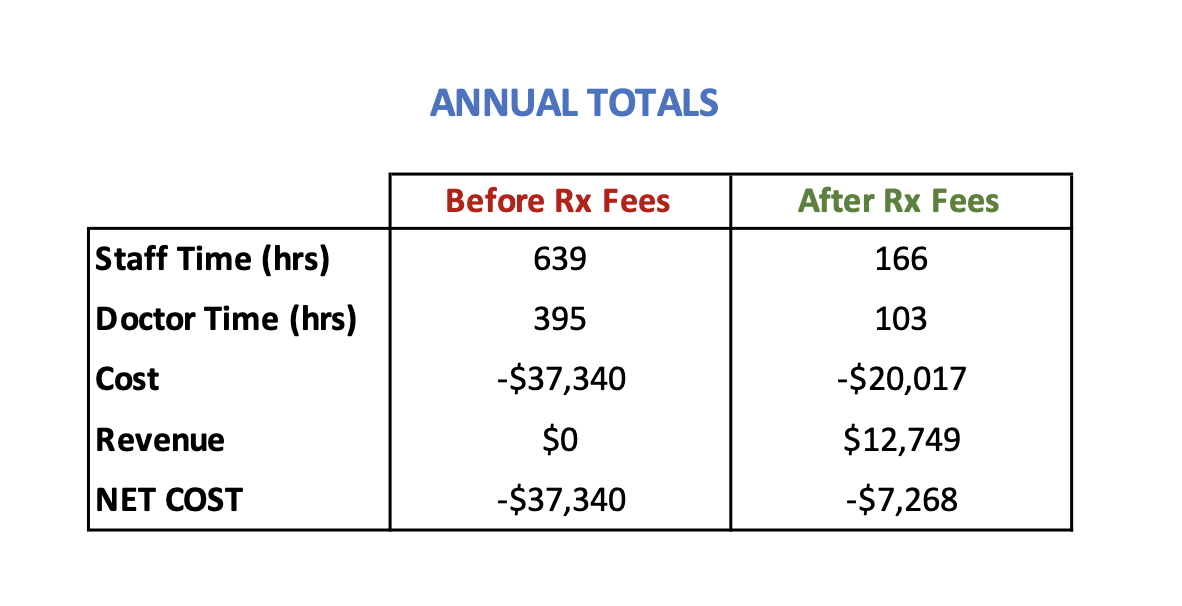
For all parameters, the outcomes were better with prescription renewal fees. Less staff time. Less doctor time. More revenue. Less net cost.
It is unmistakably more costly to keep ‘simply’ renewing prescription requests without a visit nor fee.
A Word about Balanced Accessibility:
I think this goes without saying, but doctors certainly should not extort patients.
If you are going to charge a fee for a prescription renewal without a visit, then you must also be able to offer the alternative of the patient coming in for the insured service of an actual visit.
My personal policy is that if I cannot offer a prescription renewal visit within two business days, then I waive the fee and simply renew the prescription. Still, this rarely happens.
That said, the patient still has the accountability of needing to provide reasonable advanced notice and not leaving requests until the last minute.
How to Get Started in Your Own Clinic
All of this sounds great and makes sense, but it can still feel like a daunting task to implement a Prescription Renewal Policy in your own clinic, especially if you’ve never charged for this service in the past.
Then again, there has never been a better time in which to frame and explain the need to patients. This is an era of 5-10% inflation, 20% rise in overhead costs, and sub inflation ‘raises’ from OHIP. Family Doctors are burning out, retiring early, or switching careers in record numbers. Clearly, we cannot carry on providing $22 prescription renewals for free.
I strongly suggest preparing a standardized Patient Education announcement. Feel free to copy and modify my Notice to Patients to suit your own needs. Have it in several formats: paper handouts, EMR handouts, posters, mail outs, social media posting, mass email notices, etc. Have your voicemail include a notice on the new fee for prescription renewals. After a few months, your patients will be fully aware and things will fall into place.
Be sure to check out my “FAQ and Final Details” to consider for your own policy and procedures. Again, feel free to copy and modify to suit your own needs.
I never recommend undervaluing our work, but at the very least, at least charge a $5 or $10 fee to start building awareness and patient accountability. With the help of PatientSERV’s payment platform and services, you won’t have the administrative burden of billing and collecting even these seemingly small payments.
How to Schedule the Extra Prescription Renewal Visits
As illustrated above, yes, you will start having some extra visits for simple prescription renewals from patients who opt to avoid the fee. However, the workload is typically not onerous. You can expect to have a few months of increased workload, but then things will soon settle into smooth sailing. Remember, this is only a little bit of upstream investment that will pay off exponentially downstream for years to come.
All of us practice differently in different environments. There is no ‘cookie cutter’ one-size-fits-all solution. But here are some strategies to consider:
- Offer some “squeeze-in” Prescription Renewal Visits in your schedule template. Maybe one per hour. Or 2 per half day. Whatever suits your situation.
- Offer a block of quick Prescription Renewal Visits at the end of your morning and/or afternoon.
- You could even offer blocks of telephone renewal visits (so long as virtual care remains covered by OHIP). I personally do not like this option because frankly I feel telephone visits do not cause enough of an inconvenience barrier to influence patients to take accountability.
Personally, I have evolved my practice over the years such that I now simply offer a standard 20-minute visit option for prescription renewals, same as any other visit option throughout my day. I find that there is often so much to discuss at any visit, including opportunistic preventative care.
Again, you always have the option of a release valve. If you find a certain day or week gets overly busy, you can simply waive the fee and renew without a visit on those occasions.
The Burden of Extra Visits is Less than You Think
I have written a supplementary article on how to further reduce prescription renewal burden using a “Reset the Clock to 1 Year” technique”.
The average practice would see less than 1 extra prescription renewal visit per day.
PatientSERV Can Help You
So you’ve decided to take the leap of faith and start charging for prescription renewals. But how are you going efficiently bill and collect payments?
Remember, all that time and cost associated with billing for prescription renewal requests and collecting payment? Well, PatientSERV offloads much of the work from you and your staff.
Not only that, but PatientSERV has the experience and expertise to help answer all of your questions related to this or any other Uninsured Service concerns.
For more information, visit www.patientserv.ca
Highest regards,
Dr. Adam Stewart
Family Physician | Physician Advisor | PatientSERV
October 16th, 2022



